LOOKING FORWARDlarge cities as nodes in the international transaction systemThe world’slargest citiesThe figure shows the world’s largest cities in relation to the flow of goods by sea. The red arrows indicate intensive traffic. The biggest cities in the world aregenerally located right where the red arrows reach land, which at a broad level is an indication of the importance of their role in the global flow of trade.Building sustainable citiesIt may seem as a paradox, but in practice globalisation gives the localpolitical arena more influence. This is because cities represent criticalnodes and pumping stations in the flow system. They are thecentre of flows of goods, capital, information and people, and it isin cities that these flows materialise and are concentrated. It is worthnoting that 90 per cent of global trade at some point is still shippedby sea and that 14 of the world’s 19 largest cities are also port cities.It is also in cities that flow infrastructure such as harbours, airports,train stations, banks, computer servers, businesses, distributioncentres, warehouses and loading terminals is co-located. It isthere that the necessary growth factors and relevant flows intersectand economic growth can develop. In the same way that cities aredependent on flows for their economic growth, flows are dependenton strategic locations, nodes and co-locations – cities – that serve ashubs, marketplaces, disposal sites, customers and so on. As a result,the subnational level becomes the execution level in a flow society.Back to the futureIt is hardly a radical idea that cities would be important in a systemwhere trade flows take precedence over national borders, exactly likein the Dumbarton Oaks system. One example is the system thatexisted in Europe before Westphalia. When the concept of thenational state was introduced in Europe in the 17th century, in ourregion it replaced the Hansa, an urban trading alliance that workedfor around 400 years. In the Hanseatic League, cities joined togetherto trade with each other and trade routes were protected by theleague’s own navy. Joint security and trade policies were stipulatedannually on Hansa days.What is new is the magnitude of cities’ importance in the modernworld. Their value and influence has grown in pace with urban populations,globalisation and economic development, and has beenfurther strengthened by the fact that cities and their mayors areincreasingly organising themselves nationally and internationally.Environmental issues in particular illustrate the growing involvementand influence of cities, which is logical since most resources areconsumed and pollutants generated in and around cities.The Urban MillenniumA milestone in urbanisation was reached in 2007 when 50 per cent ofthe world’s population lived in cities. For 2030 the projection is over60 per cent. By 2050, no less than 70 per cent of the world’s populationis expected to be urban. The 2000’s are sometimes called theUrban Millennium.6 saab <strong>ANNUAL</strong> <strong>REPORT</strong> <strong>2009</strong>
LOOKING FORWARDAccording to recent data, the 100 largest cities account forupwards of 30 per cent of global BNP, and the 30 largest cities 18 percent. Of the world’s 100 largest economies, perhaps less than half aremetropolitan regions, a large number of which are American. Forthis reason, cities are often called the world’s growth engines.For his part, President Obama has stated that the US needs a federalpolicy for metropolitan regions, since cities are the engines ofeconomic growth and the building blocks of strong regions. Afterhis inauguration, the president created the White House Office ofUrban Affairs.Building sustainable cities means protecting the flowsociety’s nodes and pumping stations and ensuring thatcritical flows are uninterrupted. The most importantchallenge is to avoid functional interruptions andbreakdowns due to a lack of capacity and maintenanceof critical systems.Building sustainable cities means protecting flows, economicgrowth and society as a wholeBuilding sustainable cities means protecting the flow society’s nodesand pumping stations and ensuring that critical flows are uninterrupted.Aside from perhaps the most important challenge to avoidfunctional interruptions and breakdowns due to a lack of capacityand maintenance of critical systems, the traditional threat scenariosfrom criminality, sabotage and terror still remain.Public announcements by authorities, city officials and collaboratingcompanies regarding sustainability-related urban projectsoften emphasise the environment. The fact is, however, that sustainabilityin a broad sense encompasses problems, technologies andsolutions traditionally found in the defence and security sector. Inpractice, this just as much involves surveillance, management, logistics,training, efficiency and security as the environment – and representsa huge market.A city that is environmentally, socially and economically sustainableis not sustainable if it is too vulnerable to short term threatssuch as terrorism, recessions, natural disasters and infrastructuralbottlenecks. Maintaining a large city is a complex job. Urban functionalityand security require a highly efficient infrastructure totransport people and goods, water and energy supplies and wastesystems.<strong>Saab</strong>’s technological base fits perfectly in urban environments, i.e.,surveillance, control and coordination of a city’s vital flows. Globalcities’ surveillance, control and action systems are just as advancedtoday as military systems, and their command centres are designed inlargely the same way. A city consists of more or less integrated systemsthat are managed round-the-clock in real time, which is not farfrom what <strong>Saab</strong> specialises in on the military end.<strong>Saab</strong> has been working for years to find civil applications for itskey technologies. Initially, this has led to the development of securitysolutions for flow-critical facilities such as nuclear power plants, harboursand airports. To a growing extent, it will also involve managinglarge civil flows – surveillance, control, oversight, efficiency – particularlyin large cities. Today <strong>Saab</strong> has a relatively small share of itsoperations in these areas. However, we expect cities and relatedinterests to increase in importance for the company. If the nationalstate can be called a power centre in the Westphalian system, citiescan be considered increasingly influential strategic players in thepost-Westphalian system, particularly since the budgets of majorcities are growing over time in relation to many national states.Leaders of the world’s cities are facing challenges of previouslyunknown character and magnitude, since their cities are dependenton flows, at the same time as their efforts are decisive to maintainingthese flows in an efficient, sustainable and safe manner. The budgetsavailable for security solutions in a broad sense in the world’s majorcities are larger in many cases than the corresponding budgets fornational security. If you also add solutions to enhance the operatingfunctionality and efficiency of these cities, the budget volumesincrease many times over.Looked at this way, as more and more people are doing, the marketto build sustainable cities is not only huge. This increasinglyintegrated market also constitutes part of modern society’s overallsecurity system – all within the framework of the Dumbarton Oaksdoctrine.saab <strong>ANNUAL</strong> <strong>REPORT</strong> <strong>2009</strong> 7


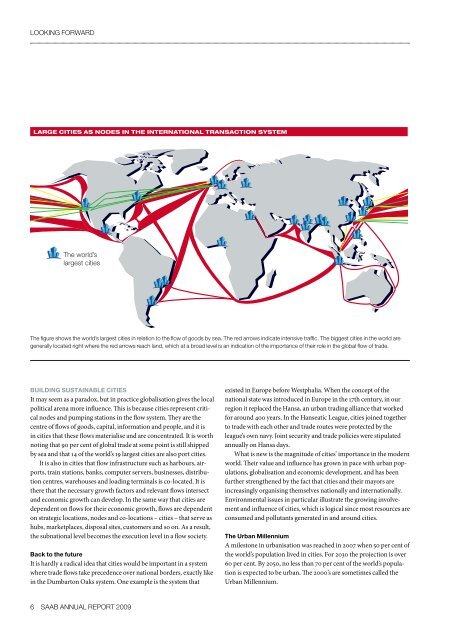

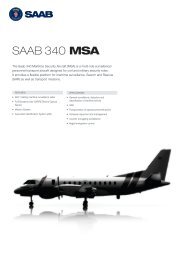
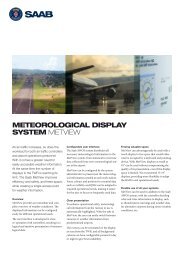
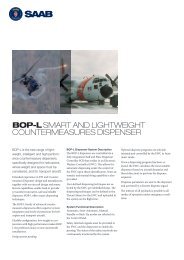



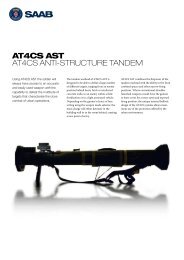


![Proposal long-term incentive programs [pdf] - Saab](https://img.yumpu.com/50411723/1/190x245/proposal-long-term-incentive-programs-pdf-saab.jpg?quality=85)


